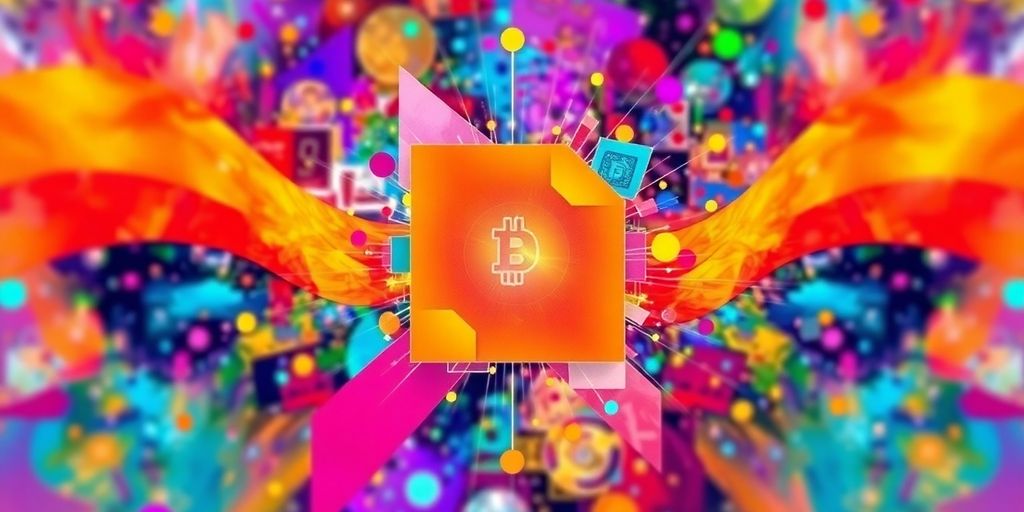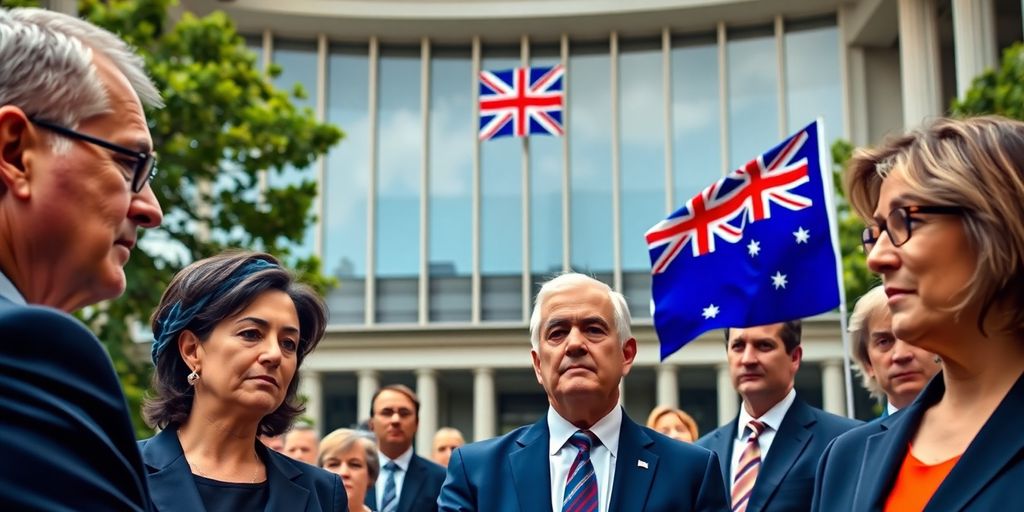Non-Fungible Tokens (NFTs) are changing the way we think about ownership in the digital world. They allow artists to sell their work directly to collectors, bypassing traditional galleries and auction houses. This new technology not only empowers artists but also creates new opportunities for collectors and investors. As we explore how NFTs reshape art by enabling digital ownership and decentralized marketplaces, we will uncover the many ways this innovation is impacting the art world.
Key Takeaways
- NFTs allow artists to sell their digital art directly to buyers, keeping more profits.
- They create unique digital assets that prove ownership and authenticity.
- The use of blockchain technology makes transactions secure and transparent.
- NFTs open doors for new artists by removing traditional barriers in the art market.
- Collectors can own exclusive digital items that may appreciate in value.
NFTs: A New Era in Digital Art Ownership
Understanding the Concept of NFTs
NFTs, or Non-Fungible Tokens, represent a groundbreaking shift in how we think about digital ownership. Unlike traditional assets, NFTs are unique and cannot be exchanged on a one-to-one basis. This uniqueness allows us to own digital art, music, and other creations in a way that was not possible before. NFTs provide a way to authenticate and prove ownership of digital assets.
How NFTs Authenticate Digital Art
The process of authentication is crucial in the digital art world. NFTs use blockchain technology to create a permanent record of ownership. This means that when we buy an NFT, we are not just purchasing a digital file; we are acquiring a verified piece of art that is unique to us.
The Role of Blockchain in Digital Ownership
Blockchain technology is the backbone of NFTs. It ensures that each token is distinct and traceable. Here are some key points about blockchain’s role in digital ownership:
- Transparency: Every transaction is recorded on the blockchain, making it easy to verify ownership.
- Security: The decentralized nature of blockchain protects against fraud and unauthorized duplication.
- Accessibility: Anyone can access the blockchain, allowing for a global marketplace for digital art.
In this new era, we are witnessing a transformation in how art is created, bought, and sold. The possibilities are endless, and the art world is evolving rapidly.
By embracing NFTs, we are not just participating in a trend; we are part of a movement that is reshaping the future of art and ownership.
Decentralized Marketplaces: Revolutionizing Art Sales

The Shift from Traditional to Digital Marketplaces
In recent years, we have witnessed a significant shift from traditional art sales to digital marketplaces. This change has allowed artists to sell their work directly to collectors, eliminating the need for galleries and auction houses. By using platforms like Binance NFT, artists can reach a wider audience and keep more of their earnings.
Benefits for Artists and Collectors
The benefits of decentralized marketplaces are numerous:
- Direct sales: Artists can sell their work without intermediaries, allowing for better profit margins.
- Global reach: Creators can connect with collectors from around the world, expanding their audience.
- Transparency: Blockchain technology ensures that all transactions are secure and verifiable, giving collectors confidence in their purchases.
Challenges in the Decentralized Art Market
Despite the advantages, there are challenges we must consider:
- Market volatility: The value of NFTs can fluctuate greatly, making it risky for both artists and collectors.
- Environmental concerns: The energy consumption of blockchain technology raises sustainability questions.
- Legal issues: The lack of regulation in the NFT space can lead to disputes over ownership and copyright.
The rise of decentralized marketplaces is reshaping the art world, providing new opportunities and challenges for artists and collectors alike.
In conclusion, as we navigate this new landscape, it is essential to understand both the benefits and challenges that come with decentralized art sales. By embracing these changes, we can help create a more inclusive and dynamic art market.
Empowering Artists Through NFTs

Direct-to-Consumer Sales Models
One of the most exciting aspects of NFTs is how they allow artists to sell their work directly to fans. This direct-to-consumer model means that artists can keep more of the money they earn. Here are some key benefits of this approach:
- Higher Profits: Artists can earn more by avoiding gallery fees.
- Control Over Pricing: Creators can set their own prices without outside influence.
- Building Relationships: Artists can connect directly with their audience, fostering a loyal fan base.
Smart Contracts and Royalties
NFTs also introduce smart contracts, which are like digital agreements that automatically execute when conditions are met. This technology can help artists earn ongoing royalties. For example:
- Resale Royalties: Artists can receive a percentage every time their work is resold.
- Transparency: Smart contracts provide clear records of sales and ownership.
- Fair Compensation: This ensures that artists are rewarded for their work over time.
Global Reach and Audience Expansion
With NFTs, artists can showcase their work to a worldwide audience. This global reach opens up new opportunities for creators. Here’s how:
- Access to New Markets: Artists can reach collectors from different countries.
- Diverse Audiences: Creators can connect with fans who appreciate their unique style.
- Increased Visibility: Online platforms allow artists to gain exposure without traditional barriers.
NFTs are transforming the art world by empowering artists with tokenized digital assets. This shift is reshaping how we think about ownership and creativity in the digital age.
NFTs and the Democratization of the Art World
Breaking Down Barriers for Emerging Artists
The rise of NFTs is democratizing the art world, allowing artists from various backgrounds to showcase their work without traditional barriers. This shift means that anyone with talent can reach a global audience. Here are some key points about this change:
- Accessibility: Artists no longer need to rely on galleries to display their work.
- Diverse Representation: More artists from different cultures and backgrounds can gain visibility.
- Direct Sales: Creators can sell directly to collectors, keeping more profits.
Creating Inclusive Art Communities
NFTs are fostering inclusive communities where artists and collectors can connect directly. This is important because:
- Collaboration: Artists can work together across borders.
- Support Networks: Emerging artists can find mentors and supporters online.
- Community Engagement: Collectors can engage with artists in new ways, enhancing the art experience.
Impact on Traditional Art Institutions
The traditional art world is feeling the effects of this shift. Some impacts include:
- Changing Roles: Galleries and auction houses must adapt to the new landscape.
- New Business Models: Institutions are exploring how to incorporate NFTs into their offerings.
- Market Dynamics: The value of art is being redefined as more artists enter the market.
The emergence of NFTs is reshaping how we think about art ownership and access, creating a more equitable landscape for all artists.
In conclusion, NFTs are not just a trend; they are a powerful tool for art democratization. By breaking down barriers, creating inclusive communities, and impacting traditional institutions, NFTs are paving the way for a more diverse and accessible art world.
The Economic Impact of NFTs on the Art Market
New Revenue Streams for Artists
NFTs have opened up new revenue streams for artists, allowing them to sell their digital works directly to collectors. This direct-to-consumer approach means that artists can keep a larger share of the profits. Here are some key benefits:
- Bypassing intermediaries: Artists no longer need to rely on galleries or auction houses.
- Ongoing royalties: Smart contracts can ensure that artists receive a percentage of sales every time their work is resold.
- Global reach: Artists can connect with audiences worldwide, breaking down geographical barriers.
Market Dynamics and Valuation
The NFT market is rapidly evolving, with sales volumes skyrocketing. For instance, the number of NFT sales per week has jumped from 100 in 2017 to potentially 50,000 in 2022. This growth reflects a shift in how we value digital art. Factors influencing this market include:
- Rarity: Unique pieces tend to fetch higher prices.
- Artist reputation: Well-known artists often see their works valued more highly.
- Utility: NFTs that offer additional benefits can command premium prices.
| Year | Weekly Sales Volume |
|---|---|
| 2017 | 100 |
| 2022 | 50,000 |
Investment Opportunities in Digital Art
For collectors, NFTs represent a chance to invest in unique digital assets. The secure nature of blockchain technology adds confidence in the authenticity of these pieces. As the market matures, we can expect:
- Increased interest from both collectors and investors.
- Potential appreciation in value over time.
- A more diverse range of digital art available for purchase.
NFTs are reshaping the art market by enabling digital ownership and creating new opportunities for artists and collectors alike. As we navigate this new landscape, it’s essential to understand the economic implications and embrace the changes that come with it.
Technological Foundations of NFTs

Blockchain Technology Explained
Blockchain is the backbone of non-fungible tokens (NFTs). It acts as a secure and transparent ledger that records every transaction. Each transaction is stored in a block, which is linked to previous blocks, forming a chain. This structure ensures that data remains intact and cannot be altered. The most popular blockchain for NFTs is Ethereum, but others like Flow and Tezos are also gaining traction.
The Role of Smart Contracts
Smart contracts are self-executing contracts with the terms of the agreement directly written into code. They automate processes and ensure that transactions are executed only when certain conditions are met. This technology is crucial for NFTs as it allows for automatic royalty payments to creators whenever their work is resold, ensuring they benefit from their creations long-term.
Security and Authenticity in Digital Transactions
The security of NFTs is paramount. By using blockchain technology, NFTs provide a tamper-proof record of ownership. This means that once an NFT is created, its authenticity can be verified at any time. This feature is essential for artists and collectors, as it protects against fraud and ensures that the value of digital art is preserved.
The combination of blockchain, smart contracts, and security measures creates a robust framework for digital ownership, transforming how we interact with art and collectibles.
In summary, the technological foundations of NFTs are built on:
- Blockchain technology for secure transactions.
- Smart contracts for automated agreements and royalties.
- Security measures to ensure authenticity and protect ownership.
These elements work together to create a new landscape for digital ownership, making NFTs a revolutionary force in the art world.
Challenges and Controversies Surrounding NFTs
As we explore the world of Non-Fungible Tokens (NFTs), it’s essential to recognize the challenges and controversies that accompany this innovative technology. While NFTs are reshaping digital ownership, they also raise significant concerns that we must address.
Environmental Concerns and Sustainability
One of the most pressing issues is the environmental impact of NFTs. The process of minting and trading NFTs on blockchain networks, particularly those using proof-of-work systems, consumes a lot of energy. This has led to a high carbon footprint, sparking debates about whether the benefits of NFTs justify their environmental costs. Here are some key points to consider:
- High energy consumption during transactions
- Calls for more sustainable alternatives
- The need for eco-friendly blockchain solutions
Legal and Regulatory Issues
Another challenge we face is the regulatory uncertainty surrounding NFTs. As this market grows, questions about legal classification, taxation, and potential fraud arise. The lack of clear regulations can lead to confusion and mistrust among artists and collectors. Important aspects include:
- Unclear legal status of NFTs
- Concerns about fraud and money laundering
- The need for a robust regulatory framework
Market Speculation and Volatility
Finally, the NFT market is often characterized by speculation and volatility. Prices can fluctuate dramatically, leading to concerns about the long-term viability of investments in digital art. This unpredictability can deter potential buyers and artists alike. We should be aware of:
- Rapid price changes in the NFT market
- Risks associated with speculative investments
- The impact of market trends on artists’ livelihoods
In summary, while NFTs offer exciting opportunities for digital ownership, we must navigate the challenges they present to ensure a sustainable and equitable future for all stakeholders in the art world.
NFTs Beyond Art: Expanding Use Cases
As we explore the world of NFTs, it becomes clear that their impact extends far beyond just art. NFTs are revolutionizing various industries, including real estate, ticketing, and even healthcare. This expansion showcases the versatility of blockchain technology and its potential to reshape how we think about ownership and value.
NFTs in Gaming and Virtual Real Estate
In the gaming industry, NFTs allow players to own unique in-game items and characters. This means that gamers can trade and sell their digital assets, creating real-world value from virtual items. Here are some key points about NFTs in gaming:
- Players can truly own their digital assets.
- Unique items can be traded in secondary markets.
- This model adds a new layer of engagement for gamers.
Applications in Music and Entertainment
NFTs are also making waves in the music industry. Artists can sell limited-edition albums and concert tickets as NFTs, providing fans with exclusive access. This opens up new revenue streams for musicians and enhances fan engagement. Some benefits include:
- Direct sales to fans without intermediaries.
- Opportunities for ongoing royalties through smart contracts.
- Enhanced fan experiences with exclusive content.
Future Prospects in Various Industries
Looking ahead, the potential for NFTs to represent ownership of physical assets is exciting. By linking digital twins of real-world objects to NFTs, we can streamline processes like property transfers and luxury goods authentication. This convergence of digital and physical realms could unlock new opportunities for:
- Creators to monetize their work.
- Investors to explore new asset classes.
- Consumers to engage with products in innovative ways.
The future of NFTs is bright, and their applications are limitless. As we continue to explore these possibilities, we can expect to see significant changes in how we interact with digital and physical assets.
The Future of NFTs and Digital Ownership

As we look ahead, the future of NFTs seems bright and full of potential. Many believe that NFTs represent the future of digital ownership, as they empower creators by removing middlemen like art galleries and record labels. This shift not only benefits artists but also opens up new avenues for brands and companies to engage with their audiences.
Evolving Trends in NFT Technology
The landscape of NFTs is constantly changing. Here are some key trends we can expect:
- Increased Adoption: More artists and creators are likely to embrace NFTs, leading to a wider variety of digital assets.
- Integration with Physical Assets: NFTs may start representing ownership of real-world items, making transactions smoother and more secure.
- Sustainability Efforts: As concerns about the environment grow, we anticipate advancements in blockchain technology that will make NFTs more energy-efficient.
Potential for Decentralized Finance
NFTs are not just about art; they are also paving the way for decentralized finance (DeFi). This could mean:
- New Financial Models: Artists can earn royalties from every resale of their work, creating ongoing revenue streams.
- Crowdfunding Opportunities: Creators can raise funds directly from their fans through NFT sales.
- Investment Platforms: NFTs could become a new asset class for investors, diversifying portfolios.
The future of NFTs is not just about ownership; it’s about creating a community where artists and collectors can thrive together.
Long-term Implications for Creators and Collectors
As NFTs continue to evolve, we foresee several long-term impacts:
- Empowerment of Artists: Creators will have more control over their work and how it is sold.
- Enhanced Engagement: Fans can connect with artists in new ways, fostering a sense of community.
- Market Growth: The NFT market is expected to expand, offering more opportunities for both creators and collectors.
In conclusion, the future of NFTs and digital ownership is filled with exciting possibilities. As we navigate this new landscape, we must remain open to the changes and challenges that lie ahead, ensuring that we harness the full potential of this innovative technology.
Conclusion
In conclusion, NFTs are changing the way we think about art and ownership in the digital world. They allow artists to sell their work directly to buyers, which means they can keep more of the money they earn. This new way of selling art also helps lesser-known artists get noticed and reach people all over the globe. As we move forward, it’s clear that NFTs are not just a trend; they are reshaping the art market and giving artists more power. By embracing this technology, we can look forward to a future where creativity and ownership are more accessible to everyone.
Frequently Asked Questions
What exactly are NFTs?
NFTs, or non-fungible tokens, are special digital items that show ownership of unique things like art, music, or videos. Unlike regular money, each NFT is one-of-a-kind and can’t be traded for another.
How do NFTs work?
NFTs use blockchain technology, usually on Ethereum, to prove who owns them. Each NFT has a unique digital signature that makes it easy to tell them apart. This signature keeps a permanent record of ownership.
Why are NFTs important for artists?
NFTs give artists a new way to sell their digital work directly to buyers without needing galleries or middlemen. This helps them keep more money and control how their art is shared.
Can anyone buy NFTs?
Yes, anyone with internet access and a cryptocurrency wallet can buy NFTs. However, you usually need to use cryptocurrencies like Ethereum to make these purchases.
Are NFTs a smart investment?
NFTs can be good investments, but like any investment, they come with risks. Some NFTs may increase in value over time, while others might not.
What are the benefits of using NFTs?
NFTs create digital scarcity, which can make digital art more valuable. They also allow artists to earn money from resales through smart contracts.
What challenges do NFTs face?
NFTs have some issues, like concerns about their environmental impact and the need for clear rules and regulations to protect buyers and sellers.
What other uses do NFTs have besides art?
NFTs can be used in many areas, including gaming, music, and even virtual real estate, making them a versatile tool for creators.





